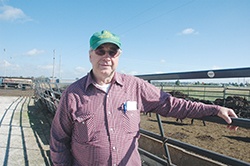Cattle Industry Still Suffering Effects of Last Years Drought
by October 14, 2013 12:00 am 92 views

Arkansas farmers generally are resigned to the fact that their livelihood depends on the temperament of the weather.
They learn to be flexible, to set back a little extra on successful years, because they know — at some point — they will need it.
Each year, fewer young people are up for the challenge, and because of this, the cattle farmer population is steadily shrinking and getting older.
In July and August, at the peak of the rain shortage, 90 percent of Arkansas experienced “severe” drought, and 50 percent experienced “exceptional” drought, according to the U.S. Drought Monitor.
Eighty-five percent of all rangeland in Arkansas was considered to be in poor or very poor condition, according to a report from the University of Arkansas Division of Agriculture Research & Extension.
With pastures dwindling, the cost of hay to feed cows skyrocketed. Farmers were paying twice the usual price — up to $60 or $70 a bale, said Kidd, whose farm is in Lincoln.
Even the most buoyant of cattle managers are still reeling from the disaster, preceded by years of steady decline in the industry, and experts say it will take years for cattle production to get back to where it was.
Transition Phase
For farmers planning to get out of the business soon, the drought provided a window to do so, said Travis Justice, executive director of the Arkansas Beef Council.
Others had to borrow money or were forced to sell off part of their herd.
“There’s no way to figure how much money [the drought] cost me,” Kidd said. “All I know is, I’m still in business, but I couldn’t survive without bank loans.”
Prairie Grove cattle farmer Charles Moore ended up selling 28 heifers last year, in order to close one of his farms and consolidate his herd.
Although this year has been wetter for most areas of the state, save for one short dry spell, Moore has not yet been able to replenish his cattle, because prices are so high, he said.
Once an adult cow is sold, it takes a while to replace it, Moore said. Heifers must reach two years before they can produce.
The cattle inventory in Arkansas has reached a 60-year low, Justice said.
Cattle production has declined 2 to 3 percent each year since 2010, and Justice predicts a larger drop in the numbers this year.
The industry, however, should stabilize within the next few years, barring any unforeseen environmental or market interventions, Justice said.
In the meantime, consumers are paying record-high prices for beef, an average of $5.30 a pound. And, with demand high and production low, experts say this trend will likely continue in the next few years.
With prices high, one might think profits follow. However, at the same time, the investment farmers must make continues to increase drastically.
“While cattle and beef prices are high, so is everything else,” said Mike Looper, head of animal science at the UA.
Looper estimates the cost to maintain a cow is now $1.80-$2 per day, whereas just five years ago farmers paid $1.30-$1.50 per day.
Northwest Arkansas is still a hub for cattle production, boasting two counties (Washington and Benton) in the top 25 U.S. cattle producers, Looper said.
In addition, the industry is at its height of efficiency, Looper said. Farmers use science and technology to meet demand with far fewer animals because they can grow them bigger.
So, Looper does not believe the cattle industry is in trouble, but rather in a “transition” phase, he said. “And it’s a long road ahead.”
